Friday, September 29, 2006
Tern up for the books
A brief interlude on Thurs PM allowed a quick wander around Cosmeston Lakes late afternoon. I wasn't expecting any decent birds, just wanted some fresh air before tackling roundabouts in the rush hour with a nervous pupil.
I had nearly completed my circuit of the larger lake, when a small, but familiar shape appeared low over the water. A quick look though the bins revealed another Black Tern. I phoned it in and later put it on GBC website.
I received a text from Wayne Strong this PM. It's his local patch, and he's never seen one there...ooops! Apparently it's only the 2nd or 3rd record ever there.....
Wednesday, September 27, 2006
Some more good terns..
A morning free from teaching the youth of Cardiff how not to crash a car gave me the opportunity to seek out some Autumn migrants. Goldcliff, with 9 Curlew Sands, and 9 Little Stints, was tempting, but I'd recently seen both species when watching the Semi-P.
A report of 3 Black and 1 Arctic Tern at Eglwys Nunydd proved more tempting, and sure enough these 4 birds were easily found near the entrance to the reservoir. I left my camera at home, and regretted it, as both species came very close to me.
An adult Med Gull was amongst the Black Headed, and at least 3 Common Sands were around.
Not quite as exciting as the Picos last week, but a pleasant interlude....
Sunday, September 24, 2006
Yellow Wag in the Bag
Not that I ever doubted seeing one for a minute! ;-)
One Yellow Wagtail at Kenfig Pool today. Also 1 Little Stint and the Black Tern still present. If only I'd been there this morning and I might have got onto the Hobby seen by SJM. Doh!
Picos de Europa 16-23rd Sept 06
The Picos de Europa are a range of limestone mountains in Northern Spain, rising to about 8500ft, and a couple of hundred miles west of the Pyrennes.
Saturday.
We travelled by train to Stansted via London, flew to Bilbao and drove a hire car for about 2.5 hours to our hotel for the first 3 nights, in the hills near the small town of Potes. We arrived around midnight.
Sunday.
As breakfast wasn't until 9am (typically Spanish), we went for a stroll down the road from the hotel before it. A Black Redstart was soon found, and a couple of hundred yards further on a male Cirl Bunting showed well. A loud but distant call from the valley bottom was almost certainly a Wryneck, but although we heard it several times in the next few days, we never saw it.
After breakfast, we drove the few miles into Potes for provisions, as a few Crag Martins flew overhead. A Red Squirrel scurried across the road in front of us.
As the weather was cool and drizzly, we decided to drive for a while. At one small village, another showy Black Redstart flitted around, and as we watched, a flock of Serin landed in a tree behind it. We reached the small town of Raina as it brightened slightly, and stopped to scan a large reservoir there. There was little on there, the highlight being a Yellow Legged Gull. A couple of stork's nests were empty, unfortunately. A distant dot over the mountains grew rapidly into a huge raptor, my first Griffon Vulture. Soon there were seven of them, and they drifted fairly low over us, excellent.
We stopped several times on the way back, but mainly only found familiar species. A Black Kite was sat in a field, but there was nowhere to stop and watch it properly.
I went for another stroll from the hotel early evening, and found at least three more Cirl Buntings.
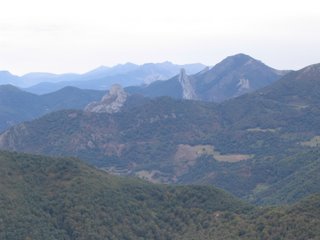
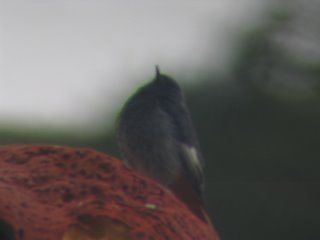

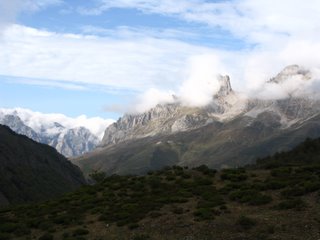 Monday. A brighter day, with some clouds over the high mountains.
We decided to do a circular walk from the hotel, and soon were in woods. Crested Tits were heard, but couldn't be found. Out in the open, we soon started finding butterflies: Clouded Yellows were very common, several Adonis Blues, our first Brown Hairstreaks, a Lesser Purple Emperor, Mazarine Blues, and lots of Long Tailed Blues, amongst more familiar species including hundreds of Wall and Grayling.
A Booted Eagle drifted over, and Griffon Vultures were usually visible above nearby high mountains, drifting in and out of clouds.
Monday. A brighter day, with some clouds over the high mountains.
We decided to do a circular walk from the hotel, and soon were in woods. Crested Tits were heard, but couldn't be found. Out in the open, we soon started finding butterflies: Clouded Yellows were very common, several Adonis Blues, our first Brown Hairstreaks, a Lesser Purple Emperor, Mazarine Blues, and lots of Long Tailed Blues, amongst more familiar species including hundreds of Wall and Grayling.
A Booted Eagle drifted over, and Griffon Vultures were usually visible above nearby high mountains, drifting in and out of clouds.

 Tuesday. Hot and sunny.
Whilst having breakfast on the terrace, more Serins were buzzing around, but they were soon ignored when a bird flew into one the closest trees to us. It was a male Middle Spotted Woodpecker, and it's mate was soon found a little further away.
We drove to a nearby valley, parked near the village at the end of the road, and prepared to walk into the mountains. As we were putting our boots on, a Short Toed Eagle showed well over a nearby wood. In the village, an old lady insisted on giving us apricots from her apron full of them. Although we ate some during the walk, we still had 36 of them left when we finished!
We passed Pied Flycatchers and a Marsh Tit, as well as Crag Martins, and the enevitable Black Redstarts.
Large brown lizards basked on rocks, and small green ones shot off before a camera could be aimed at them.
Higher up, we were rewarded with a stunning view, and 18 Griffon Vultures together. Keep moving, or they'll think you're a snack!
A pair of Rock Buntings showed well, and a few others were seen later on. A Large Wall Brown had us puzzled for a while, and a Meadow Fritillary posed nicely. A long dusty walk was livened by crickets that we flushed every few yards. Some showed pink in flight, and some showed bright blue. Nice!
We were nearly back at the car when Gill found a Praying Mantis, green and stunning. I found a brown one, looking just like a clothes peg!
We then had a short drive to our self catering apartment, where we stayed for the rest of the week, eating mainly apricots....
Tuesday. Hot and sunny.
Whilst having breakfast on the terrace, more Serins were buzzing around, but they were soon ignored when a bird flew into one the closest trees to us. It was a male Middle Spotted Woodpecker, and it's mate was soon found a little further away.
We drove to a nearby valley, parked near the village at the end of the road, and prepared to walk into the mountains. As we were putting our boots on, a Short Toed Eagle showed well over a nearby wood. In the village, an old lady insisted on giving us apricots from her apron full of them. Although we ate some during the walk, we still had 36 of them left when we finished!
We passed Pied Flycatchers and a Marsh Tit, as well as Crag Martins, and the enevitable Black Redstarts.
Large brown lizards basked on rocks, and small green ones shot off before a camera could be aimed at them.
Higher up, we were rewarded with a stunning view, and 18 Griffon Vultures together. Keep moving, or they'll think you're a snack!
A pair of Rock Buntings showed well, and a few others were seen later on. A Large Wall Brown had us puzzled for a while, and a Meadow Fritillary posed nicely. A long dusty walk was livened by crickets that we flushed every few yards. Some showed pink in flight, and some showed bright blue. Nice!
We were nearly back at the car when Gill found a Praying Mantis, green and stunning. I found a brown one, looking just like a clothes peg!
We then had a short drive to our self catering apartment, where we stayed for the rest of the week, eating mainly apricots....



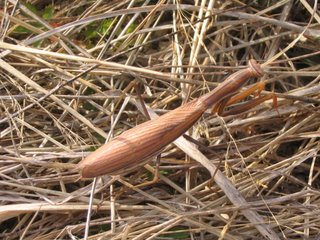 Wednesday.
The forecast was for a hot sunny day, with light winds, so we headed for Alpine habitat.
An hour's drive brought us to the car park for the Fuente De cable car, which climbs 2400ft to approx 5500ft in less than 4 minutes, saving hours of hard walking. We were advised to be there early, to avoid queuing for the cable car.
Whilst we waited, a flock of Red Billed Choughs fed in a field, Griffon Vultures perched on the rocks high above, Rock Buntings and White Wagtails were on grass outside a hotel.
We took the first cable car at 10am, and within a few minutes of leaving the station, a pair of Alpine Choughs flew past. Gill saw a small bird in flight, so we looked for it, as anything that high up was likely to be interesting. It was an Alpine Accentor. Soon, however, a party of loud Spaniards approached, and flushed it.....
Water Pipits were numerous up here, as were Black Redstarts, and Linnets. However, we had information about a far rarer and elusive species that was sometimes seen about 20 mins walk away.
A couple from Norfolk walked with us, as they were also looking for the same species. We soon reached the cliff face that we expected to scan for hours, and looked for comfortable boulders to sit on for our vigil. Before we had chance to sit, Gill saw a small bird flitting between the boulders below us. A couple of minutes later, it popped up, and gave myself and the gentleman from Norfolk good, but brief views, of a Wallcreeper! Yes!
Unfortunately, the ladies missed it, so we waited another hour, and gradually the bird approached us, until it was within 25 feet of us. We all had good binocular views (the scope was in the car, as a long walk awaited us). Eventually, it flew a long way down the slope, and we said goodbye to the Norfolk birders.
We began to gradually descend, pausing to admire a couple of small groups of "Spanish" Yellow Wagtails. We stopped for lunch at a refuge (more like a hotel and bar) at 4500 feet.
A pair of Alpine Choughs hung around, and as soon as we left our picnic table, they lived up to my families nickname for them of "Picnic Crows", by investigating our table for crumbs.
Shortly afterwards, a small raptor flew past, and a brief view proved it to be a stunning male Lesser Kestrel.
No new birds or butterflies were seen lower down, but several hours later, as we approached the car park, a Firecrest sang briefly from some tall conifers.
Wednesday.
The forecast was for a hot sunny day, with light winds, so we headed for Alpine habitat.
An hour's drive brought us to the car park for the Fuente De cable car, which climbs 2400ft to approx 5500ft in less than 4 minutes, saving hours of hard walking. We were advised to be there early, to avoid queuing for the cable car.
Whilst we waited, a flock of Red Billed Choughs fed in a field, Griffon Vultures perched on the rocks high above, Rock Buntings and White Wagtails were on grass outside a hotel.
We took the first cable car at 10am, and within a few minutes of leaving the station, a pair of Alpine Choughs flew past. Gill saw a small bird in flight, so we looked for it, as anything that high up was likely to be interesting. It was an Alpine Accentor. Soon, however, a party of loud Spaniards approached, and flushed it.....
Water Pipits were numerous up here, as were Black Redstarts, and Linnets. However, we had information about a far rarer and elusive species that was sometimes seen about 20 mins walk away.
A couple from Norfolk walked with us, as they were also looking for the same species. We soon reached the cliff face that we expected to scan for hours, and looked for comfortable boulders to sit on for our vigil. Before we had chance to sit, Gill saw a small bird flitting between the boulders below us. A couple of minutes later, it popped up, and gave myself and the gentleman from Norfolk good, but brief views, of a Wallcreeper! Yes!
Unfortunately, the ladies missed it, so we waited another hour, and gradually the bird approached us, until it was within 25 feet of us. We all had good binocular views (the scope was in the car, as a long walk awaited us). Eventually, it flew a long way down the slope, and we said goodbye to the Norfolk birders.
We began to gradually descend, pausing to admire a couple of small groups of "Spanish" Yellow Wagtails. We stopped for lunch at a refuge (more like a hotel and bar) at 4500 feet.
A pair of Alpine Choughs hung around, and as soon as we left our picnic table, they lived up to my families nickname for them of "Picnic Crows", by investigating our table for crumbs.
Shortly afterwards, a small raptor flew past, and a brief view proved it to be a stunning male Lesser Kestrel.
No new birds or butterflies were seen lower down, but several hours later, as we approached the car park, a Firecrest sang briefly from some tall conifers.
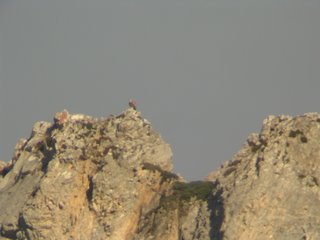
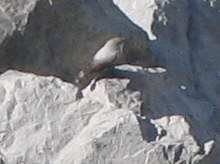

 Thursday. Warm and very windy in the morning, turning to rain in the afternoon.
We had a gentle drive to nearby valleys, not seeing anything new, before the rain began. As we were both quite tired and aching after last previous days exploits, we were not too disappointed.
Friday. Much brighter.
A long, twisty drive took us to the Cares Gorge, for an interesting walk. The Gorge makes Cheddar Gorge look like a crease in a tablecloth! As we put boots on, a pair of Golden Eagles soared over the cliffs.
We stopped for lunch by a bridge over the river, and Gill had a quick look down, and immediately found...a Wallcreeper.
We watched it for at least 45mins, and a steady stream of walkers of various nationalities passed, and only a few asked what we were watching. A few wobbly digi-binned video clips of it were obtained. A Lesser Kestrel called, and soon gave brief views.
The scenery was amazing, and we walked for a fair way along, before turning to retrace our steps. Soon I found another Wallcreeper, very close, and again, below us!
The drive back produced more Rock Buntings, a group on the road!
Thursday. Warm and very windy in the morning, turning to rain in the afternoon.
We had a gentle drive to nearby valleys, not seeing anything new, before the rain began. As we were both quite tired and aching after last previous days exploits, we were not too disappointed.
Friday. Much brighter.
A long, twisty drive took us to the Cares Gorge, for an interesting walk. The Gorge makes Cheddar Gorge look like a crease in a tablecloth! As we put boots on, a pair of Golden Eagles soared over the cliffs.
We stopped for lunch by a bridge over the river, and Gill had a quick look down, and immediately found...a Wallcreeper.
We watched it for at least 45mins, and a steady stream of walkers of various nationalities passed, and only a few asked what we were watching. A few wobbly digi-binned video clips of it were obtained. A Lesser Kestrel called, and soon gave brief views.
The scenery was amazing, and we walked for a fair way along, before turning to retrace our steps. Soon I found another Wallcreeper, very close, and again, below us!
The drive back produced more Rock Buntings, a group on the road!

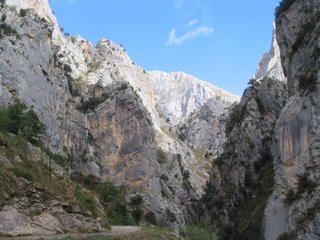
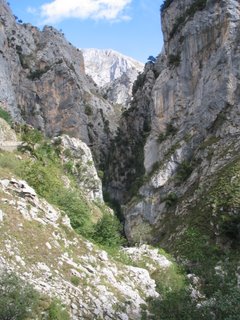
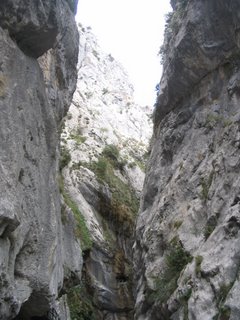 Saturday. Bright.
We began the drive back to Bilbao, where we were to spend our last night in Spain.
Flocks of birds flying over were presumed to be Spotless Starlings, as they are the common ones there, but decent views were not possible.
We stopped off at an estuary between Santander and Bilbao, and soon found about 8 Black Necked Grebes. A few Whimbrel were amongst more common waders. A small pool over the road revealed only some familiar ducks, but the field beyond it was more profitable, with a flock of approx 30 Cattle Egrets.
67 species of birds seen during the week (8 or 9 "lifers" depending on the "starling sp", 8 more heard, and 18 species of butterfly (6 "lifers").
In Bilbao, Gill dragged me along to the Guggenheim museum, bereft of wildlife, except for a Black Kite drifting over, oh, and a strange dog outside the museum........
Saturday. Bright.
We began the drive back to Bilbao, where we were to spend our last night in Spain.
Flocks of birds flying over were presumed to be Spotless Starlings, as they are the common ones there, but decent views were not possible.
We stopped off at an estuary between Santander and Bilbao, and soon found about 8 Black Necked Grebes. A few Whimbrel were amongst more common waders. A small pool over the road revealed only some familiar ducks, but the field beyond it was more profitable, with a flock of approx 30 Cattle Egrets.
67 species of birds seen during the week (8 or 9 "lifers" depending on the "starling sp", 8 more heard, and 18 species of butterfly (6 "lifers").
In Bilbao, Gill dragged me along to the Guggenheim museum, bereft of wildlife, except for a Black Kite drifting over, oh, and a strange dog outside the museum........
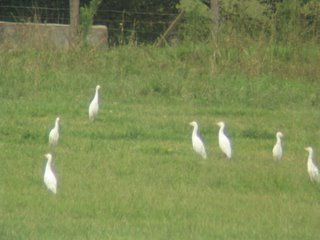
 Sunday.
An uneventful journey home, the highlight being a couple of pints of excellent Fuller's Hock at Paddington Station, and proper British food- Chicken Tikka Masala!
Sunday.
An uneventful journey home, the highlight being a couple of pints of excellent Fuller's Hock at Paddington Station, and proper British food- Chicken Tikka Masala!



 Monday. A brighter day, with some clouds over the high mountains.
We decided to do a circular walk from the hotel, and soon were in woods. Crested Tits were heard, but couldn't be found. Out in the open, we soon started finding butterflies: Clouded Yellows were very common, several Adonis Blues, our first Brown Hairstreaks, a Lesser Purple Emperor, Mazarine Blues, and lots of Long Tailed Blues, amongst more familiar species including hundreds of Wall and Grayling.
A Booted Eagle drifted over, and Griffon Vultures were usually visible above nearby high mountains, drifting in and out of clouds.
Monday. A brighter day, with some clouds over the high mountains.
We decided to do a circular walk from the hotel, and soon were in woods. Crested Tits were heard, but couldn't be found. Out in the open, we soon started finding butterflies: Clouded Yellows were very common, several Adonis Blues, our first Brown Hairstreaks, a Lesser Purple Emperor, Mazarine Blues, and lots of Long Tailed Blues, amongst more familiar species including hundreds of Wall and Grayling.
A Booted Eagle drifted over, and Griffon Vultures were usually visible above nearby high mountains, drifting in and out of clouds.

 Tuesday. Hot and sunny.
Whilst having breakfast on the terrace, more Serins were buzzing around, but they were soon ignored when a bird flew into one the closest trees to us. It was a male Middle Spotted Woodpecker, and it's mate was soon found a little further away.
We drove to a nearby valley, parked near the village at the end of the road, and prepared to walk into the mountains. As we were putting our boots on, a Short Toed Eagle showed well over a nearby wood. In the village, an old lady insisted on giving us apricots from her apron full of them. Although we ate some during the walk, we still had 36 of them left when we finished!
We passed Pied Flycatchers and a Marsh Tit, as well as Crag Martins, and the enevitable Black Redstarts.
Large brown lizards basked on rocks, and small green ones shot off before a camera could be aimed at them.
Higher up, we were rewarded with a stunning view, and 18 Griffon Vultures together. Keep moving, or they'll think you're a snack!
A pair of Rock Buntings showed well, and a few others were seen later on. A Large Wall Brown had us puzzled for a while, and a Meadow Fritillary posed nicely. A long dusty walk was livened by crickets that we flushed every few yards. Some showed pink in flight, and some showed bright blue. Nice!
We were nearly back at the car when Gill found a Praying Mantis, green and stunning. I found a brown one, looking just like a clothes peg!
We then had a short drive to our self catering apartment, where we stayed for the rest of the week, eating mainly apricots....
Tuesday. Hot and sunny.
Whilst having breakfast on the terrace, more Serins were buzzing around, but they were soon ignored when a bird flew into one the closest trees to us. It was a male Middle Spotted Woodpecker, and it's mate was soon found a little further away.
We drove to a nearby valley, parked near the village at the end of the road, and prepared to walk into the mountains. As we were putting our boots on, a Short Toed Eagle showed well over a nearby wood. In the village, an old lady insisted on giving us apricots from her apron full of them. Although we ate some during the walk, we still had 36 of them left when we finished!
We passed Pied Flycatchers and a Marsh Tit, as well as Crag Martins, and the enevitable Black Redstarts.
Large brown lizards basked on rocks, and small green ones shot off before a camera could be aimed at them.
Higher up, we were rewarded with a stunning view, and 18 Griffon Vultures together. Keep moving, or they'll think you're a snack!
A pair of Rock Buntings showed well, and a few others were seen later on. A Large Wall Brown had us puzzled for a while, and a Meadow Fritillary posed nicely. A long dusty walk was livened by crickets that we flushed every few yards. Some showed pink in flight, and some showed bright blue. Nice!
We were nearly back at the car when Gill found a Praying Mantis, green and stunning. I found a brown one, looking just like a clothes peg!
We then had a short drive to our self catering apartment, where we stayed for the rest of the week, eating mainly apricots....



 Wednesday.
The forecast was for a hot sunny day, with light winds, so we headed for Alpine habitat.
An hour's drive brought us to the car park for the Fuente De cable car, which climbs 2400ft to approx 5500ft in less than 4 minutes, saving hours of hard walking. We were advised to be there early, to avoid queuing for the cable car.
Whilst we waited, a flock of Red Billed Choughs fed in a field, Griffon Vultures perched on the rocks high above, Rock Buntings and White Wagtails were on grass outside a hotel.
We took the first cable car at 10am, and within a few minutes of leaving the station, a pair of Alpine Choughs flew past. Gill saw a small bird in flight, so we looked for it, as anything that high up was likely to be interesting. It was an Alpine Accentor. Soon, however, a party of loud Spaniards approached, and flushed it.....
Water Pipits were numerous up here, as were Black Redstarts, and Linnets. However, we had information about a far rarer and elusive species that was sometimes seen about 20 mins walk away.
A couple from Norfolk walked with us, as they were also looking for the same species. We soon reached the cliff face that we expected to scan for hours, and looked for comfortable boulders to sit on for our vigil. Before we had chance to sit, Gill saw a small bird flitting between the boulders below us. A couple of minutes later, it popped up, and gave myself and the gentleman from Norfolk good, but brief views, of a Wallcreeper! Yes!
Unfortunately, the ladies missed it, so we waited another hour, and gradually the bird approached us, until it was within 25 feet of us. We all had good binocular views (the scope was in the car, as a long walk awaited us). Eventually, it flew a long way down the slope, and we said goodbye to the Norfolk birders.
We began to gradually descend, pausing to admire a couple of small groups of "Spanish" Yellow Wagtails. We stopped for lunch at a refuge (more like a hotel and bar) at 4500 feet.
A pair of Alpine Choughs hung around, and as soon as we left our picnic table, they lived up to my families nickname for them of "Picnic Crows", by investigating our table for crumbs.
Shortly afterwards, a small raptor flew past, and a brief view proved it to be a stunning male Lesser Kestrel.
No new birds or butterflies were seen lower down, but several hours later, as we approached the car park, a Firecrest sang briefly from some tall conifers.
Wednesday.
The forecast was for a hot sunny day, with light winds, so we headed for Alpine habitat.
An hour's drive brought us to the car park for the Fuente De cable car, which climbs 2400ft to approx 5500ft in less than 4 minutes, saving hours of hard walking. We were advised to be there early, to avoid queuing for the cable car.
Whilst we waited, a flock of Red Billed Choughs fed in a field, Griffon Vultures perched on the rocks high above, Rock Buntings and White Wagtails were on grass outside a hotel.
We took the first cable car at 10am, and within a few minutes of leaving the station, a pair of Alpine Choughs flew past. Gill saw a small bird in flight, so we looked for it, as anything that high up was likely to be interesting. It was an Alpine Accentor. Soon, however, a party of loud Spaniards approached, and flushed it.....
Water Pipits were numerous up here, as were Black Redstarts, and Linnets. However, we had information about a far rarer and elusive species that was sometimes seen about 20 mins walk away.
A couple from Norfolk walked with us, as they were also looking for the same species. We soon reached the cliff face that we expected to scan for hours, and looked for comfortable boulders to sit on for our vigil. Before we had chance to sit, Gill saw a small bird flitting between the boulders below us. A couple of minutes later, it popped up, and gave myself and the gentleman from Norfolk good, but brief views, of a Wallcreeper! Yes!
Unfortunately, the ladies missed it, so we waited another hour, and gradually the bird approached us, until it was within 25 feet of us. We all had good binocular views (the scope was in the car, as a long walk awaited us). Eventually, it flew a long way down the slope, and we said goodbye to the Norfolk birders.
We began to gradually descend, pausing to admire a couple of small groups of "Spanish" Yellow Wagtails. We stopped for lunch at a refuge (more like a hotel and bar) at 4500 feet.
A pair of Alpine Choughs hung around, and as soon as we left our picnic table, they lived up to my families nickname for them of "Picnic Crows", by investigating our table for crumbs.
Shortly afterwards, a small raptor flew past, and a brief view proved it to be a stunning male Lesser Kestrel.
No new birds or butterflies were seen lower down, but several hours later, as we approached the car park, a Firecrest sang briefly from some tall conifers.



 Thursday. Warm and very windy in the morning, turning to rain in the afternoon.
We had a gentle drive to nearby valleys, not seeing anything new, before the rain began. As we were both quite tired and aching after last previous days exploits, we were not too disappointed.
Friday. Much brighter.
A long, twisty drive took us to the Cares Gorge, for an interesting walk. The Gorge makes Cheddar Gorge look like a crease in a tablecloth! As we put boots on, a pair of Golden Eagles soared over the cliffs.
We stopped for lunch by a bridge over the river, and Gill had a quick look down, and immediately found...a Wallcreeper.
We watched it for at least 45mins, and a steady stream of walkers of various nationalities passed, and only a few asked what we were watching. A few wobbly digi-binned video clips of it were obtained. A Lesser Kestrel called, and soon gave brief views.
The scenery was amazing, and we walked for a fair way along, before turning to retrace our steps. Soon I found another Wallcreeper, very close, and again, below us!
The drive back produced more Rock Buntings, a group on the road!
Thursday. Warm and very windy in the morning, turning to rain in the afternoon.
We had a gentle drive to nearby valleys, not seeing anything new, before the rain began. As we were both quite tired and aching after last previous days exploits, we were not too disappointed.
Friday. Much brighter.
A long, twisty drive took us to the Cares Gorge, for an interesting walk. The Gorge makes Cheddar Gorge look like a crease in a tablecloth! As we put boots on, a pair of Golden Eagles soared over the cliffs.
We stopped for lunch by a bridge over the river, and Gill had a quick look down, and immediately found...a Wallcreeper.
We watched it for at least 45mins, and a steady stream of walkers of various nationalities passed, and only a few asked what we were watching. A few wobbly digi-binned video clips of it were obtained. A Lesser Kestrel called, and soon gave brief views.
The scenery was amazing, and we walked for a fair way along, before turning to retrace our steps. Soon I found another Wallcreeper, very close, and again, below us!
The drive back produced more Rock Buntings, a group on the road!



 Saturday. Bright.
We began the drive back to Bilbao, where we were to spend our last night in Spain.
Flocks of birds flying over were presumed to be Spotless Starlings, as they are the common ones there, but decent views were not possible.
We stopped off at an estuary between Santander and Bilbao, and soon found about 8 Black Necked Grebes. A few Whimbrel were amongst more common waders. A small pool over the road revealed only some familiar ducks, but the field beyond it was more profitable, with a flock of approx 30 Cattle Egrets.
67 species of birds seen during the week (8 or 9 "lifers" depending on the "starling sp", 8 more heard, and 18 species of butterfly (6 "lifers").
In Bilbao, Gill dragged me along to the Guggenheim museum, bereft of wildlife, except for a Black Kite drifting over, oh, and a strange dog outside the museum........
Saturday. Bright.
We began the drive back to Bilbao, where we were to spend our last night in Spain.
Flocks of birds flying over were presumed to be Spotless Starlings, as they are the common ones there, but decent views were not possible.
We stopped off at an estuary between Santander and Bilbao, and soon found about 8 Black Necked Grebes. A few Whimbrel were amongst more common waders. A small pool over the road revealed only some familiar ducks, but the field beyond it was more profitable, with a flock of approx 30 Cattle Egrets.
67 species of birds seen during the week (8 or 9 "lifers" depending on the "starling sp", 8 more heard, and 18 species of butterfly (6 "lifers").
In Bilbao, Gill dragged me along to the Guggenheim museum, bereft of wildlife, except for a Black Kite drifting over, oh, and a strange dog outside the museum........

 Sunday.
An uneventful journey home, the highlight being a couple of pints of excellent Fuller's Hock at Paddington Station, and proper British food- Chicken Tikka Masala!
Sunday.
An uneventful journey home, the highlight being a couple of pints of excellent Fuller's Hock at Paddington Station, and proper British food- Chicken Tikka Masala!
Saturday, September 23, 2006
Three in a Row
While I can't compete with Wayne's exploits at Slimbridge I had a surprisingly good day out within the confines of good ol' Eastern Glamorgan today.
Having received my 'afternoon pass' for good behaviour I was humming and
ha-ing whether I should go to Lavernock Point (easterly winds + chance of Yellow Wag) when up popped the news on the GBC site that there were two Little Stints at Kenfig Pool. Half an hour later I was at the edge of the pool looking at . . . . a Black Tern. A nice bit of deja vu after yesterday's success in finding 2 Black Terns at Eglwys Nunydd but, more importantly, this species was now well and truly on my Eastern Glamorgan Year List.
Normally I would have given the Black Tern a bit more attention but I was still anxious to find the Little Stints. No sooner said than done - there they were a little way ahead of me. Feeling a bit guilty that I'd neglected the Black Tern I went back and enjoyed watching it for another five minutes.
For some reason I decided to move on to Porthcawl to walk from Pink Bay to Sker. It was a long slog in very windy conditions, with too many people around and no birds. I remember now why I went there - there'd been reports of Knot on Kenfig Beach lately, and Sker Point can be good for Yellow Wags at this time of the year (you've probably twigged that I'm getting a bit obsessed with getting Yellow Wag on my Glam list this year) - unfortunately, neither were present.
Back at the car I decided to pack it in for the day and head for home. But why not call in at Wig Fach for the 43rd time this year to look for R-L Partridge? Why not? Well, even though I could think of a least a dozen reasons why not, I pulled in at the bus stop opposite the turn off for Wig Fach and scanned the dirt field. Incredibly, there in front of me were 7 of the little blighters - not only a Glam Year List tick but a Glam lifer!
After arriving home I immediately logged on to put my sightings on the GBC website. But, before I'd typed a word I was off out of the house again and on my way to Lisvane Reservoir. PB had had two Black Terns and a Common Tern there that morning. By now I wasn't too fussed about Black Terns (only joking - they're lovely birds) but I need the Common Tern for my Glam Year List.
Dragging Gethin along with me ("You can only go if you take Gethin with you") I was in luck again. The two Black Terns and a juv Common Tern were still there. Three Glamorgan Year List ticks in a day and a bonus Eastern Glamorgan tick too. Who needs to watch the Ryder Cup for excitement?
These birds bring my year list totals up to the following:
Year List = 192 :-(
Glamorgan = 163
Eastern Glamorgan = 157
Anyone know where I can find a Yellow Wag?!
Seven Slimbridge Sandpipers
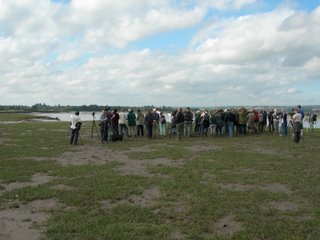 After another poor night's sleep, I bit the bullet and made an impulsive early morning dash to Slimbridge with the intention of ticking some Yankee waders.
In the car park at 7:15am, a small crowd was greeted by a warden advising that we could go along to the Holden Tower and wait for news. A few of his colleagues were already out on the Dumbles looking for the birds. After about an hour a warden returned to the tower with the news that one buff-breasted sandpiper had been located and we now had to wait for the tide to bring the waders in. We would then need to wait for them to settle.
After another poor night's sleep, I bit the bullet and made an impulsive early morning dash to Slimbridge with the intention of ticking some Yankee waders.
In the car park at 7:15am, a small crowd was greeted by a warden advising that we could go along to the Holden Tower and wait for news. A few of his colleagues were already out on the Dumbles looking for the birds. After about an hour a warden returned to the tower with the news that one buff-breasted sandpiper had been located and we now had to wait for the tide to bring the waders in. We would then need to wait for them to settle.
 Around 10:20am we began the long march out to the Dumbles. Its muddy out there I can tell you. We were however, soon on to the pair of buff-breasted sandpipers.
Satisfied with good views, we turned our attention to the nearby semipalmated sandpiper that the wardens had seen coming in to roost. I was keen to see this bird having missed out on the Goldcliff individual two weeks ago. A few other Gwent birders had the same plan.
This peep proved elusive, but was eventually tracked down by the Gloucestershire Recorder who had ventured onto the mud. A crowd of over fifty birders then followed onto the slippery surface. The bird was roosting alongside a dunlin and little stint. Comparisons were possible, but the view wasn't really satifactory, as it was not possible to see the whole bird out in the open. Anyway, it was a peep show and was duly ticked.
With two lifers under my belt, I returned to the South Lake for what was now four reported pectoral sandpipers. I squeezed in to a busy hide and took just a few minutes to pick the foursome out.
Around 10:20am we began the long march out to the Dumbles. Its muddy out there I can tell you. We were however, soon on to the pair of buff-breasted sandpipers.
Satisfied with good views, we turned our attention to the nearby semipalmated sandpiper that the wardens had seen coming in to roost. I was keen to see this bird having missed out on the Goldcliff individual two weeks ago. A few other Gwent birders had the same plan.
This peep proved elusive, but was eventually tracked down by the Gloucestershire Recorder who had ventured onto the mud. A crowd of over fifty birders then followed onto the slippery surface. The bird was roosting alongside a dunlin and little stint. Comparisons were possible, but the view wasn't really satifactory, as it was not possible to see the whole bird out in the open. Anyway, it was a peep show and was duly ticked.
With two lifers under my belt, I returned to the South Lake for what was now four reported pectoral sandpipers. I squeezed in to a busy hide and took just a few minutes to pick the foursome out.  .
Satisfied with two lifers and a year tick I headed for home. Also ticked during the visit were the Gloster Birder amongst a flock of Gloucestershire birders and LGRE sporting a dapper white shirt and black tie.
.
Satisfied with two lifers and a year tick I headed for home. Also ticked during the visit were the Gloster Birder amongst a flock of Gloucestershire birders and LGRE sporting a dapper white shirt and black tie.
One Good Tern . . . .
. . . . well, two actually.
Not having been able to get out birding much lately it was a relief to get my Glamorgan Year List inching forward again.
I've been working up in Swansea for the last fortnight and I've been carrying my 'scope and bins in the back of the car just in case something turned up locally. And yesterday something did.
There was news on the GBC Sightings page of 2 Black Terns at Eglwys Nunydd reservoir at 0930. I called in quickly on the way back to Cardiff and managed to tick them off within a couple of minutes. Nice and easy!
This brings my Glamorgan total for the year up to 160 (East Glam is stuck on 153). Not bad, but could do better. I've got about ten easy ticks left but I've given up on Hobby and I'm getting a bit worried about Yellow Wagtail and Ring Ousel. Having 'lost' most of Septemeber I'll be chuffed if I get a total of around 175. What we need are a few more scarcities!
Wednesday, September 13, 2006
Oozing with Ouzels
In preparation for our holiday in the Picos de Europa, Northern Spain, I decided to use a few spare hours to break in my new walking boots a bit more. I climbed the hill beyond Craig Cerrig Gleisiad (SN9621), and returned along the cliff edge above the Ring Ouzel site.
A Red Kite, a few Swallows and a brief Wheatear were seen, but as I began to descend, I heard a chacking Ouzel, and soon found it about 30 yards away from me, and below me. It was a stunning male. It flew past me onto the cliff face, where I watched it and several other flitting amongst the Rowans. I would guess at least 6 birds were present, including a couple of juvs.
Monday, September 11, 2006
Peep Show
I was just about to set off for Goldcliff on Saturday lunchtime, when a text from Tim warned me that the semipalmated sandpiper was moving away with the receding tide. I was left with the choice of an evening visit later in the day, or an early morning trip. I concluded that a Sunday morning visit would be best. I'd have better light, a high-tide and more hours to spend. In the end, the bird turned up again on Saturday, so I was hopeful of a life tick on Sunday.
I arrived at 7:00am on Sunday, dismayed to find the first pool completely flooded, and a handful of birders standing on platform 3. I just got there in time to secure a viewing position before the crowds arrived. Four little stints were soon picked out along with a couple of curlew sandpipers. After about twenty minutes, a birder called that he was on our target. Further scrutiny revealed however, that it was a fifth little stint just arrived from the shoreline. Four avocets circled overhead, knots arrived in good numbers along with a third curlew sandpiper, dunlins and a large flock of curlews. We remained optimistic, given the continued arrival of birds. A group of eight and a lone yellow wagtail flew through along with a tree pipit and green woodpecker.
The morning started to drag on however, as our bird was nowhere to be seen. It started to become a question of tick the birder, as people began to come and go. Many unable to get on platform 3 and going to the seawall instead. It was clear that many of these birders had actually seen the bird already and were coming for a 2nd, 3rd and 4th look. These included the finder and one wise man.
Chatting with a few people there, it seems there is a slight grain of doubt about the identity of this bird. Its almost certainly a semipalmated sandpiper, but showing a few anomalous characterstics. Unfortunately, in three hours, I never got the chance to see for myself. I was consoled that at least it was just my first trip, as others were dipping for the 2nd or 3rd time. I also managed three year ticks - little stint, curlew sandpiper and yellow wagtail.
Okay, so the peep didn't show, but that's not a snappy title for a blog entry.
Subscribe to:
Posts (Atom)